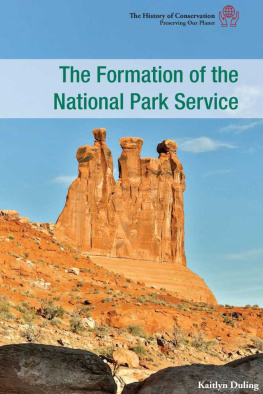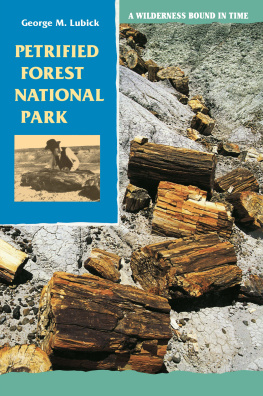
AMERICAS NATIONAL PARKS SERIES
Char Miller, Pomona College, Series Editor
Americas National Parks promotes the close investigation of the complex and often-contentious history of the nations many national parks, sites, and monuments. Their creation and management raises a number of critical questions from such fields as archaeology, geology and history, biology, political science, and sociology, as well as geography, literature, and aesthetics. Books in this series aim to spark public conversation about these landscapes enduring value by probing such diverse topics as ecological restoration, environmental justice, tourism and recreation, tribal relations, the production and consumption of nature, and the implications of wildland fire and wilderness protection. Even as these engaging texts cross interdisciplinary boundaries, they will also dig deeply into the local meanings embedded in individual parks, monuments, or landmarks and locate these special places within the larger context of American environmental culture.
Death Valley National Park: A History by Hal K. Rothman and Char Miller
Grand Canyon: A History of a Natural Wonder and National Park by Don Lago
Lake Mead National Recreation Area: A History of Americas First National Playground by Jonathan Foster
Coronado National Memorial: A History of Montezuma Canyon and the Southern Huachucas by Joseph P. Sanchez
Glacier National Park: A Culmination of Giants by George Bristol
Big Bend National Park: Mexico, the United States, and a Borderland Ecosystem by Michael Welsh
Americas National Parks Series
Series Editor, Char Miller, Pomona College
University of Nevada Press, Reno, Nevada 89557 USA
Copyright 2021 by University of Nevada Press
All rights reserved
LIBRARY OF CONGRESS CATALOGING-IN-PUBLICATION DATA
Names: Welsh, Michael E., author.
Title: Big Bend National Park : Mexico, the United States, and a borderland ecosystem / Michael Welsh.
Other titles: Americas national parks series.
Description: Reno : University of Nevada Press, [2021] | Series: Americas national parks series | Includes bibliographical references and index. | Summary: Big Bend National Park: Mexico, the United States, and a Borderland Ecosystem is the story of binational cooperation along the Rio Grande/Ro Bravo corridor. Audiences in Mexico and the United States may find compelling the description of public and private efforts to create a unique memorial to friendship, even as it reveals how often cultural differences get in the wayProvided by publisher.
Identifiers: LCCN 2020051249 (print) | LCCN 2020051250 (ebook) | ISBN 9781948908825 (paperback) | ISBN 9781948908832 (ebook)
Subjects: LCSH: Big Bend National Park (Tex.)History. | Big Bend Region (Tex.)History. | Mexican-American Border RegionHistory.
Classification: LCC F392.B53 W45 2021 (print) | LCC F392.B53 (ebook) | DDC 976.4/932dc23
LC record available at https://lccn.loc.gov/2020051249
LC ebook record available at https://lccn.loc.gov/2020051250
Manufactured in the United States of America
25 24 23 22 21 5 4 3 2 1
ILLUSTRATIONS
Following
FIGURES
Kickapoo Indians from Mexico at Rio Grande Hot Springs (ca. 1920)
US Geological Survey of Rio Grande Canyons (1899)
North Peak of Chisos Mountains (1899)
Santa Elea Canyon (1899)
US Geological Survey crew crossing boulders in Santa Elea Canyon (1899)
Walter Prescott Webb (1942)
Civilian Conservation Corps camp in Chisos Basin (1934)
CCC workers on the Window Trail (1934)
CCC roadwork (1934)
Miguel Angel de Quevedo, director, Departemento Forestal, Caza y Pesca, Republic of Mexico (undated)
Daniel F. Galicia, chief inspector, Departemento Forestal, Caza y Pesca, Republic of Mexico, preparing for overflight of proposed international park (January 1936)
George Melndez Wright, chief, Wildlife Division, National Park Service, upon return from overflight of proposed international park (January 1936)
International Park Commission vehicle being towed across the Rio Grande in Big Bend (January 1936)
International Park Commission staff and oldest residents of San Carlos, Chihuahua, Mexico (ca. 1936)
International Park Commission in Boquillas, Mexico (January 1936)
Visitors at American overlook of Boquillas, Mexico (ca. 1950)
Big Bend park visitor on outskirts of Boquillas, Mexico (1965)
Lady Bird Johnson and Interior Secretary Stewart Udall entering canoe for river trip through Mariscal Canyon (April 1966)
MAPS
National Park Service map of Big Bend National Park (2020)
Map of protected areas in Mexico adjacent to Big Bend National Park (2020)
Property map of Mexican landownership in proposed international park (1936)
PREFACE
The year 2019 marked the diamond jubilee of the establishment of Big Bend National Park. Much has been written for the past seventy-five years and more about the region of Far West Texas and northern Mexico that includes the landscape known as the Big Bend. Given this name for the turn in the river called the Rio Grande (Great river) on the American side and El Rio Bravo (The wild river) to the south, the Big Bend country has drawn the attention of the scholar, the novelist, the artist, and the photographer for over a century. So it was intriguing to have a colleague from my graduate school days at the University of New Mexico, Art Gomez of the National Park Service (NPS), propose in 1994 that I write an administrative history of this vast stretch of 801,000 acres.
While on the staff of the Santa Fe office of the park service, Art had published his own institutional analysis of the region for the years before establishment of the park, entitled A Most Singular Country: A History of Occupation in the Big Bend (1990). What the NPS needed, said Art, was a thorough assessment of its operations and management of the natural and cultural resources that the agency had guarded since 1944. A recent study of the park, published in 1996 by John Jameson, had appeared on the fiftieth anniversary of Big Bends creation. The book examined key individuals and moments of change in park history, offering a welcome addition to the shelf of literature about Big Bends flora, fauna, and colorful historical characters.
With these studies in print, the value of an organizational analysis of Texass first national park seemed appropriate. As surely as the flow of the Rio Grande carved the landscape of the Big Bend, so too did Arts statement affect my research and writing: In the long term, the Park Service made the most longstanding contributions to the regions final settlement. Given the environmental distinctiveness of the area, and its profound social context, it seemed wise to connect these important themes with the broader story of the area that became known in the nineteenth century as a borderland. This initial effort appeared as an NPS publication entitled Landscape of Ghosts, River of Dreams: An Administrative History of Big Bend National Park (2002).
In the years after its appearance on the NPS website, this latter study drew interest from scholars and the general public, as did the Big Bend country itself. New scholarship emerged on its themes, emphasizing breakthroughs in the areas of environmental, transnational, and imperial history. Academic innovations stressed admixtures of social and ecological change along the geographic corridors above and below Big Bend. It seemed appropriate in the second decade of the twenty-first century, with its political and media attention on the broader arc of the boundary between the two nations, that the story of Big Bend be introduced to a new generation.




